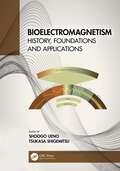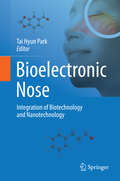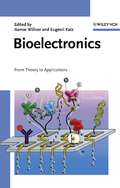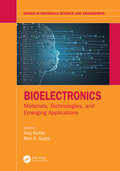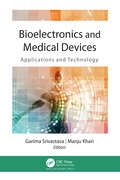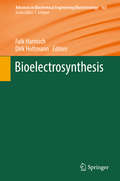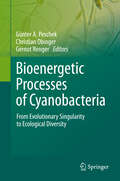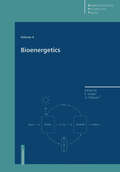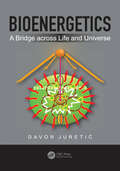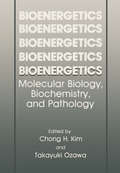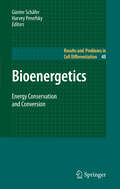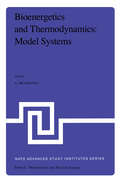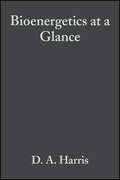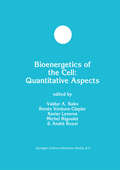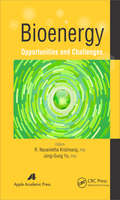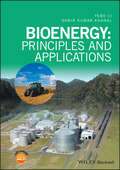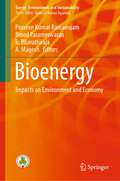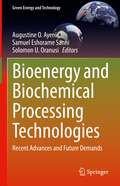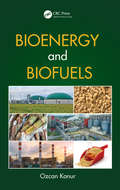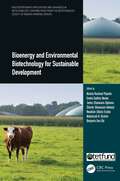- Table View
- List View
Bioelectromagnetism: History, Foundations and Applications
by Shoogo Ueno Tsukasa ShigemitsuBioelectromagnetism has been gradually developing and expanding into a variety of fields in engineering, biomedical engineering, life science, medicine and biology. Bioelectromagnetism: History, Foundations and Applications provides an overview of the field and its developments; from its inception and growth through the twenty-first century, to the latest advances in electro- and magnetobiology and hazard evaluations of electromagnetic fields.It is organized into three sections, each focusing on specific regions of bioelectromagnetism. It begins with the foundations of the field and its history, with a chronological treatment of the major subjects in bioelectromagnetism. The relationship between atmospheric electromagnetic phenomena, geomagnetism and biological systems are presented. It then discusses the many benefits of bioelectromagnetism: electroreception, magnetic navigation, magnetic sense and magnetic responses of plants, birds, animals and humans. It then moves on to human health issues and the impact of bioelectromagnetism. It also provides practical guidance on how to set safety guidelines. Finally, it looks forward to the future prospects of the field based on the latest research in the field.In exploring both the history of the field and the latest developments in today’s research advances, this book provides a comprehensive and self-contained treatment on the subject, which will be a valuable reference for researchers in biophysics, medicine, electrical engineering and biomedical engineering.It can be used as a companion to the editor’s previously published books: Biomagnetics: Principles and Applications of Biomagnetic Stimulation and Imaging (9781482239201, 2016, CRC Press); and Bioimaging: Imaging by Light and Electromagnetics in Medicine and Biology (9780367203047, 2020, CRC Press).Key Features: Provides both a historical view of the field, along with the latest developments in the field Contains practical guidance for researchers on how to set safety guidelines for those working in the area Edited by authorities in the field, with chapter contributions from specialists
Bioelectronic Nose: Integration of Biotechnology and Nanotechnology
by Tai Hyun ParkThe “bioelectronic nose”, the device which has a similar function to the human smell sensing system, can be realized by combining the olfactory cells or receptors with nanotechnology. In the last two decades, much has been learned about the smell sensing mechanism in biological systems. With knowledge about the biological olfactory system and the techniques for the expression of biological receptor proteins, we are able to utilize biological materials and systems to mimic the biological olfactory system. In addition to the advances in biological and biotechnological area, nanotechnology has progressed to a great degree. The bioelectronic nose is a good example of the integration of biotechnology and nanotechnology. This book describes basic biological sciences of the olfactory system, biotechnology for the production of olfactory biological elements, and nanotechnology for the development of various sensing devices. The purpose of this book is to provide the reader with a concept, basic sciences, fundamental technologies, applications, and perspectives of the bioelectronic nose.
Bioelectronics: From Theory to Applications
by Eugenii Katz Itamar WillnerMedicine, chemistry, physics and engineering stand poised to benefit within the next few years from the ingenuity of complex biological structures invented and perfected by nature over millions of years. This book provides both researchers and engineers as well as students of all the natural sciences a vivid insight into the world of bioelectronics and nature's own nanotechnological treasure chamber.
Bioelectronics: Materials, Technologies, and Emerging Applications (Series in Materials Science and Engineering)
by Anuj Kumar Ram K. GuptaBioelectronics is emerging as a new area of research where electronics can selectively detect, record, and monitor physiological signals. This is a rapidly expanding area of medical research, that relies heavily on multidisciplinary technology development and cutting-edge research in chemical, biological, engineering, and physical science. This book provides extensive information on the (i) fundamental concepts of bioelectronics, (ii) materials for the developments of bioelectronics such as implantable electronics, self-powered devices, bioelectronic sensors, flexible bioelectronics, etc, and (iii) an overview of the trends and gathering of the latest bioelectronic progress. This book will broaden our knowledge about newer technologies and processes used in bioelectronics.
Bioelectronics: Materials, Technologies, and Emerging Applications (Series in Materials Science and Engineering)
by Anuj Kumar Ram K. GuptaBioelectronics is emerging as a new area of research where electronics can selectively detect, record, and monitor physiological signals. This is a rapidly expanding area of medical research, that relies heavily on multidisciplinary technology development and cutting-edge research in chemical, biological, engineering, and physical science. This book provides extensive information on the (i) fundamental concepts of bioelectronics, (ii) materials for the developments of bioelectronics such as implantable electronics, self-powered devices, bioelectronic sensors, flexible bioelectronics, etc, and (iii) an overview of the trends and gathering of the latest bioelectronic progress. This book will broaden our knowledge about newer technologies and processes used in bioelectronics.
Bioelectronics and Medical Devices: Applications and Technology
by Garima Srivastava, Manju KhariThis new volume provides an abundance of information on new biomedical applications being used today. The book covers a wide range of concepts and technologies, discussing such modern technological methods as the Internet of Things, e-pills, biomedical sensors, support vector machines, wireless devices, image and signal processing in e-health, and machine learning. It also includes a discussion on software implementation for the devices used in biomedical applications. The different types of antennas, including antennas using RF energy harvesting for biomedical applications, are covered as well.
Bioelectronics and Medical Devices: Applications and Technology
by Garima Srivastava Manju KhariThis new volume provides an abundance of information on new biomedical applications being used today. The book covers a wide range of concepts and technologies, discussing such modern technological methods as the Internet of Things, e-pills, biomedical sensors, support vector machines, wireless devices, image and signal processing in e-health, and machine learning. It also includes a discussion on software implementation for the devices used in biomedical applications. The different types of antennas, including antennas using RF energy harvesting for biomedical applications, are covered as well.
Bioelectrosynthesis (Advances in Biochemical Engineering/Biotechnology #167)
by Falk Harnisch Dirk HoltmannThis volume discusses both the latest experimental research in bioelectrosynthesis and current applications. Beginning with an introduction into the “electrification of biotechnology” as well as the underlying fundamentals, the volume then discusses a wide range of topics based on the interfacing of biotechnological and electrochemical reaction steps. It includes contributions on the different aspects of bioelectrochemical applications for synthesis purposes, i.e. the production of fine and platform chemicals based on enzymatically or microbially catalyzed reactions driven by electric energy. The volume finishes with a summary and outlook chapter which gives an overview of the current status of the field and future perspectives. Edited by experts in the field, and authored by a wide range of international researchers, this volume assesses how research from today’s lab bench can be developed into industrial applications, and is of interest to researchers in academia and industry.
Bioenergetic Processes of Cyanobacteria: From Evolutionary Singularity to Ecological Diversity
by Guenter A. Peschek, Christian Obinger and Gernot RengerThis publication is unique among a number of books on cyanobacteria because it focuses on the bioenergetics of these widespread organisms which are the evolutionary prerequisite for the development of all higher forms of life on our "blue" planet. The book primarily addresses questions of energy conversion by the fundamental bioenergetic processes: (oxygenic) photosynthesis, (aerobic) respiration, and (anaerobic) fermentation which uniquely occur together in these prokaryotic cells. Thermophilic cyanobacteria offer the most suitable material for high resolution structure analyses of Photosystem I and II and other electron transport complexes by X-ray crystallography (for example, at present the structure of Photosystem II at atomic resolution is only known for these organisms). These achievements during the last decade represent a milestone in our understanding of the complexes which are crucial for solar energy exploitation through photosynthetic water splitting. The present work represents an ambitious attempt to achieve the goal of a synoptic state-of-the-art picture by casting together the mosaics of detailed knowledge described by leading experts in the field. It contains 24 chapters written by 35 authors from Europe, USA, India and Japan. The book is aimed at reaching a broad audience ranging from students to experienced scientists. The editors wish all readers a pleasant and stimulating journey through the fascinating “world” of the bioenergetics of cyanobacteria and sincerely hope that this book will not only be of great value for the experts but also entice young people into this exciting research area with the aim to address successfully the challenging problems of high relevance that are still waiting for a satisfactory answer.
Bioenergetics (Bioelectrochemistry: Principles and Practice #4)
by Peter Gräber Giulio MilazzoBioenergetics, the topic of volume 5 of this Series, is concerned with the energetics, the kinetics, and the mechanisms of energy conversion in biological systems. This phenomenon can be investigated on diffe rent levels of complexity. On a global level the role of biological pro cesses for the steady state of our enviroment is considered. At the physiological level, the relation between energy input and the physiolo gical state of an organism is of interest, while at the cellular level the biochemical pathways for degradation and synthesis of all relevant substrates is investigated. At present the majority of bioenergetic stu dies pertain to the molecular level. The processes in a cell are cataly zed by a large number of proteins called enzymes. The enzymes in volved in energy transduction can be considered as molecular ma chines which transform energy from one form into another, or transfer energy from one process to another. Living systems operate far from equilibrium and are open in the ther modynamic sense, i. e. they exchange energy and matter with the sur roundings. Chapter 1 presents the principles of non equilibrium thermo dynamics applied to biological systems. About 0. 05% of the energy from the sunlight which reaches the surface of the earth is used by plants and algae as well as some bacteria to synthesize organic com pounds, and thus supplies all organisms with the energy necessary for life.
Bioenergetics: A Bridge across Life and Universe
by Davor JureticBioenergetics deals with the very first energy transformation steps performed by living cells. Increased dissipation is the primary effect of processing external energy packages. Enzyme-supported charge separation is the minor but essential outcome for maintaining life. This book explores the usefulness of dissecting the entropy production of enzymes involved in cellular defenses, fermentation, respiration, and photosynthesis, assuming that tightly regulated dissipation is the hallmark of life. Researchers, educators, and students of life sciences can find in this text many examples of how we can use the interdisciplinary approach to study cells' virtuoso ability to connect the microscopic to the macroscopic world. Each chapter is a self-contained unit with a glossary and selected references for further reading.
Bioenergetics: A Bridge across Life and Universe
by Davor JureticBioenergetics deals with the very first energy transformation steps performed by living cells. Increased dissipation is the primary effect of processing external energy packages. Enzyme-supported charge separation is the minor but essential outcome for maintaining life. This book explores the usefulness of dissecting the entropy production of enzymes involved in cellular defenses, fermentation, respiration, and photosynthesis, assuming that tightly regulated dissipation is the hallmark of life. Researchers, educators, and students of life sciences can find in this text many examples of how we can use the interdisciplinary approach to study cells' virtuoso ability to connect the microscopic to the macroscopic world. Each chapter is a self-contained unit with a glossary and selected references for further reading.
Bioenergetics: Molecular Biology, Biochemistry, and Pathology
by Chong H. Kim Takayuki OzawaThe emergence of the Biochemical Sciences is underlined by the FAOB symposium in Seoul and highlighted by this Satellite meeting on the "New Bioenergetics. " Classical mitochondrial electron transfer and energy coupling is now complemented by the emerging molecular biology of the respiratory chain which is studied hand in hand with the recognition of mitochondrial disease as a major and emerging study in the basic and clinical medical sciences. Thus, this symposium has achieved an important balance of the fundamental and applied aspects of bioenergetics in the modern setting of molecular biology and mitochondrial disease. At the same time, the symposium takes note not only of the emerging excellence of Biochemical Studies in the Orient and indeed in Korea itself, but also retrospectively enjoys the history of electron transport and energy conservation as represented by the triumvirate ofYagi, King and Slater. Many thanks are due Drs. Kim and Ozawa for their elegant organization of this meeting and its juxtaposition to the FAOB Congress. Britton Chance April 2, 1990 v PREFACE This book contains the contributed papers presented at the "International Symposium on Bioenergetics: Molecular Biology, Biochemistry and Pathology", held in Seoul, Korea, August 18-21, 1989, sponsored by International Union of Biochemistry (as ruB Symposium No. 191) and Ewha Womans University, Seoul, Korea. The symposium was held in honor of Professor Kunio Yagi to commemorate his 70th birthday.
Bioenergetics: Energy Conservation and Conversion (Results and Problems in Cell Differentiation #45)
by Günter Schäfer Harvey PenefskyThe fermentation of sugar by cell-free yeast extracts was demonstrated more than a century ago by E. Buchner (Nobel Prize 1907). Buchner’s observations put an end to previous animistic theories regarding cellular life. It became clear that metabolism and all cellular functions should be accessible to explication in chemical terms. Equally important for an understanding of living systems was the concept, explained in physical terms, that all living things could be cons- ered as energy converters [E. Schrödinger (Nobel Prize 1933)] which generate complexity at the expense of an increase in entropy in their environment. Bioenergetics was established as an essential branch of the biochemical sciences by the investigations into the chemistry of photosynthesis in i- lated plant organelles [O. Warburg (Nobel Prize 1931)] and by the discovery that mitochondria were the morphological equivalent that catalyzed cellular respiration. The ?eld of bioenergetics also encompasses a large variety of ad- tional processes such as the molecular mechanisms of muscle contraction, the structure and driving mechanisms of microbial ?agellar motors, the energetics of solute transport, the extrusion of macromolecules across membranes, the transformation of quanta of light into visual information and the maintenance of complex synaptic communications. There are many other examples which, in most cases, may perform secondary energy transformations, utilizing - ergy stored either in the cellular ATP pool or in electrochemical membrane potentials.
Bioenergetics and Thermodynamics: Synthetic and Natural Chelates and Macrocycles as Models for Biological and Pharmaceutical Studies (Nato Science Series C: #55)
by A. BraibantiProceedings of the NATO Advanced Study Institute, Tabiano, Parma, Italy, May 21-June 1, 1979
Bioenergetics at a Glance: An Illustrated Introduction (At a Glance #88)
by D. A. HarrisBioenergetics is the study of the way biological systems, usually at the molecular level, utilize and convert energy in order to drive the biochemical reactions that constitute life. However, because of its often quantitative basis and the amount of technical jargon, the subject tends to alienate and intimidate students. This beautifully illustrated text has a lucid and logical approach to the subject. The text uses the modern perspective throughout so that the student is given an easily assimilable, logical introduction to the important concepts of the subject, particulary the core concept, the 'chemiosmotic theory'. It has been specifically designed to make information easily accessible by devoting each double-page spread to one topic. Within the spread, a variety of carefully constructed diagrams present information in a concise and innovative manner. The text is further enhanced by a comprehensive guide to additional reading. Original, easily understood combination of visual and written information. 43 double-page speads give a clear and concise introduction to this traditionally difficult subject. The most up to date text available, covering all modern molecular genetic techniques. Competitively priced.
Bioenergetics of the Cell: Quantitative Aspects (Developments in Molecular and Cellular Biochemistry #25)
by Valdur A. Saks Renée Ventura-Clapier Xavier Leverve André Rossi Michel RigouletThis volume continues the discussion of the problems of in vivo and in vitro. The recently solved X-ray structure of the mitochondrial creatine kinase and its molecular biology cellular bioenergetics - the tradition we started in 1994 by publication of the focused issue of Molecular and Cellular are analyzed with respect to its molecular physiology and Biochemistry, volume 133/134 and a book 'Cellular Bio functional coupling to the adenine nucleotide translocase, as energetics: role of coupled creatine kinases' edited by V. Saks well as its participation, together with the adenylate kinase and R. Ventura-Clapier and published by Kluwer Publishers, system, in intracellular energy transfer. The results of the Dordrecht -Boston. In the present volume, use of quantitative studies of creatine kinase deficient transgenic mice are methods of studies of organized metabolic systems, such as summarized and analyzed by using mathematical models of mathematical modeling and Metabolic Control Analysis, for the compartmentalized energy transfer, thus combining two investigation of the problems of bioenergetics of the cell is powerful new methods of the research. All these results, described together with presentation of new experimental together with the physiological and NMR data on the cardiac results. The following central problems of the cellular bio metabolic and mitochondrial responses to work-load changes energetics are the focus of the discussions: the mechanisms concord to the concept of metabolic networks of energy of regulation of oxidative phosphorylation in the cells in vivo transfer and feedback regulation.
Bioenergy: Opportunities and Challenges
by R. Navanietha Krishnaraj Jong-Sung YuEnergy is one of the prime needs of the modern world, and energy demands have been rapidly increasing in the recent years owing to rapid advancements in industrialization and population explosion. Conventional fossil fuels are being depleted at rapid rates, and the use of conventional sources such as coal or nuclear sources cause several hazards to
Bioenergy: Principles and Applications (Advances In Bioenergy Ser. #Volume 2)
by Yebo Li Samir Kumar KhanalThe search for altenative, renewable sources of fuel and energy from plants, algae, and waste materials has catalyzed in recent years. With the growing interest in bioenergy development and production there has been increasing demand for a broad ranging introductory text in the field. Bioenergy: Principles and Practices provides an invaluable introduction to the fundamentals of bioenergy feedstocks, processing, and industry. Bioenergy provides readers with an understanding of foundational information on 1st, 2nd, and 3rd generation biofuels. Coverage spans from feedstock production of key energy sources such as grasses, canes, and woody plants through chemical conversion processes and industrial application. Each chapter provides a thorough description of fundamental concepts, definitions of key terms, case studies and practical examples and exercises. Bioenergy: Principles and Practices will be an essential resource for students, bioengineers, chemists, and industry personnel tying key concepts of bioenergy science to valuable real world application.
Bioenergy: Principles and Applications
by Yebo Li Samir Kumar KhanalThe search for altenative, renewable sources of fuel and energy from plants, algae, and waste materials has catalyzed in recent years. With the growing interest in bioenergy development and production there has been increasing demand for a broad ranging introductory text in the field. Bioenergy: Principles and Practices provides an invaluable introduction to the fundamentals of bioenergy feedstocks, processing, and industry. Bioenergy provides readers with an understanding of foundational information on 1st, 2nd, and 3rd generation biofuels. Coverage spans from feedstock production of key energy sources such as grasses, canes, and woody plants through chemical conversion processes and industrial application. Each chapter provides a thorough description of fundamental concepts, definitions of key terms, case studies and practical examples and exercises. Bioenergy: Principles and Practices will be an essential resource for students, bioengineers, chemists, and industry personnel tying key concepts of bioenergy science to valuable real world application.
Bioenergy: Impacts on Environment and Economy (Energy, Environment, and Sustainability)
by Praveen Kumar Ramanujam Binod Parameswaran B. Bharathiraja A. MageshThis contributed volume discusses the impact of bioenergy on the environment and economy. The book contents include contributions on themes, such as the impact of emulsified biofuels on the environment, environmental impacts of the current uses of biomass energy, sustainable development in ecosystem, trends in microbial fuel cells and the ecological and economic impacts on biofuel production, among others. The book also uses visual elements to aid learning. This book is a valuable, hands-on resource for researchers, academics and industry professionals, who are interested in alternative fuels, sustainability, clean energy, biofuel production, waste management, environmental pollution, renewable energy and allied fields.
Bioenergy and Biochemical Processing Technologies: Recent Advances and Future Demands (Green Energy and Technology)
by Augustine O. Ayeni Samuel Eshorame Sanni Solomon U. OranusiThis book presents novel techniques, current trends, and cutting-edge technologies in energy and biochemical processes. The authors explore recent advances that solve challenges related to the implications and commercialization of these processes by introducing new techniques or modifying existing technologies to meet future demands for food materials, bioproducts, fossil fuels, biofuels, and bioenergy. Divided into three parts, the first section of the book addresses issues related to the utilization and management of energy towards the efficient characterization and conversion of wastes or raw-/bio- materials to useful products. The second section focuses largely on studies on molecular detection of analytes, purification, and characterization of products recovered from biochemical, enzymatic, food, and phytochemicals, as well as biostimulation and bioaugmentation processes. The final section discusses areas related to heat and mass transfer, fuel processing technologies, nanofluids, and their applications.
Bioenergy and Biofuels
by Ozcan KonurThis book aims to inform readers about the recent developments in bioenergy and biofuels covering current issues from an interdisciplinary approach. It will also feature coverage of anticipated future trends related to each particular biofuel. Chapters will consist of original research presented by world class experts in their respective fields. A number of interdisciplinary areas will be incorporated such as Energy & Fuels, Biotechology, Genomics, Economics, Optimization, Chemical Engineering, Mechanical Engineering and Algae Science. Examples will relate to a matrix of biofuel and energy types such as bioethanol, biobutanol, and biomethane.
Bioenergy and Environmental Biotechnology for Sustainable Development (Multidisciplinary Applications and Advances in Biotechnology)
by James Chukwuma Ogbonna Charles Oluwaseun Adetunji Nwadiuto Diuto Esiobu Abdulrazak B. Ibrahim Benjamin Ewa Ubi Akinola Rasheed Popoola Emeka Godfrey NwobaThis book covers a range of important topics on environmental remediation, biofuels and value-added microbial products for environmental clean-up, water and wastewater recycling and sustainable wastewater treatment using microalgae. Designed to document advances in biotechnology, this book highlights bio-resource utilization in fostering low-carbon renewable energy-based economies and provides new insights into chlorine disinfectant usage in water treatment, wastewater treatment using microalgae, etc. The book will be useful reference material for scientists and researchers in the fields of microbial biotechnology and bioremediation, environmental biotechnology and sustainable development, climate change mitigation, provision of safe water and sustainable wastewater recycling. Emphasizes recent advances in bioremediation techniques towards environmental sustainability Provides detailed information on how to harness indigenous bio-resources including microorganisms as bioenhancement agents for environmental remediation Introduces new frontiers in the area of wastewater treatment using microalgae — important for sustainability and water safety Reviews biotechniques that could enhance higher levels of sustainability in heavily polluted environments and also provides an intelligent monitoring system for waste recycling and environmental remediation, and fostering a low-carbon renewable energy–based bioeconomy Discusses the need for review of existing guidelines on chlorine disinfectant usage for enhanced water quality Akinola Rasheed Popoola, Ph.D., is a Professor of Plant Pathology and the Director of the Biotechnology Centre, Federal University of Agriculture, Abeokuta, Nigeria. Emeka Godfrey Nwoba, Ph.D., is a research scholar at the Algae Research & Development Centre, Murdoch University, Western Australia. James Chukwuma Ogbonna, Ph.D., is a Professor of Microbiology and Biotechnology and Director, National Biotechnology Development Agency, South East Zonal Biotechnology Centre, University of Nigeria, Nsukka, Nigeria. Charles Oluwaseun Adetunji, Ph.D., is an Associate Professor of Microbiology and Biotechnology, and Director of Intellectual Property and Technology Transfer, Edo State University, Uzairue, Nigeria. Nwadiuto (Diuto) Esiobu, Ph.D., is a Professor of Microbiology and Biotechnology at Florida Atlantic University, Boca Raton, FL, USA, and the President and Founder of Applied Biotech Inc. and ABINL, Abuja, Nigeria. Abdulrazak B. Ibrahim, Ph.D., is a Capacity Development Expert at the Forum for Agricultural Research in Africa (FARA) and an Associate Professor of Biochemistry, Ahmadu Bello University, Zaria, Nigeria. Benjamin Ewa Ubi, Ph.D., is a Professor of Plant Breeding and Biotechnology and Director, Biotechnology Research and Development Centre, Ebonyi State University, Abakaliki, Nigeria.
Bioenergy and Environmental Biotechnology for Sustainable Development (Multidisciplinary Applications and Advances in Biotechnology)
by Akinola Rasheed PopoolaThis book covers a range of important topics on environmental remediation, biofuels and value-added microbial products for environmental clean-up, water and wastewater recycling and sustainable wastewater treatment using microalgae. Designed to document advances in biotechnology, this book highlights bio-resource utilization in fostering low-carbon renewable energy-based economies and provides new insights into chlorine disinfectant usage in water treatment, wastewater treatment using microalgae, etc. The book will be useful reference material for scientists and researchers in the fields of microbial biotechnology and bioremediation, environmental biotechnology and sustainable development, climate change mitigation, provision of safe water and sustainable wastewater recycling. Emphasizes recent advances in bioremediation techniques towards environmental sustainability Provides detailed information on how to harness indigenous bio-resources including microorganisms as bioenhancement agents for environmental remediation Introduces new frontiers in the area of wastewater treatment using microalgae — important for sustainability and water safety Reviews biotechniques that could enhance higher levels of sustainability in heavily polluted environments and also provides an intelligent monitoring system for waste recycling and environmental remediation, and fostering a low-carbon renewable energy–based bioeconomy Discusses the need for review of existing guidelines on chlorine disinfectant usage for enhanced water quality Akinola Rasheed Popoola, Ph.D., is a Professor of Plant Pathology and the Director of the Biotechnology Centre, Federal University of Agriculture, Abeokuta, Nigeria. Emeka Godfrey Nwoba, Ph.D., is a research scholar at the Algae Research & Development Centre, Murdoch University, Western Australia. James Chukwuma Ogbonna, Ph.D., is a Professor of Microbiology and Biotechnology and Director, National Biotechnology Development Agency, South East Zonal Biotechnology Centre, University of Nigeria, Nsukka, Nigeria. Charles Oluwaseun Adetunji, Ph.D., is an Associate Professor of Microbiology and Biotechnology, and Director of Intellectual Property and Technology Transfer, Edo State University, Uzairue, Nigeria. Nwadiuto (Diuto) Esiobu, Ph.D., is a Professor of Microbiology and Biotechnology at Florida Atlantic University, Boca Raton, FL, USA, and the President and Founder of Applied Biotech Inc. and ABINL, Abuja, Nigeria. Abdulrazak B. Ibrahim, Ph.D., is a Capacity Development Expert at the Forum for Agricultural Research in Africa (FARA) and an Associate Professor of Biochemistry, Ahmadu Bello University, Zaria, Nigeria. Benjamin Ewa Ubi, Ph.D., is a Professor of Plant Breeding and Biotechnology and Director, Biotechnology Research and Development Centre, Ebonyi State University, Abakaliki, Nigeria.
